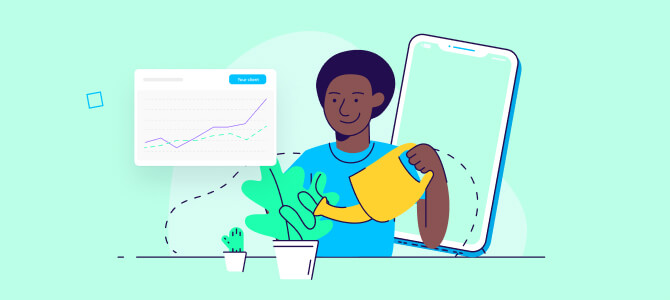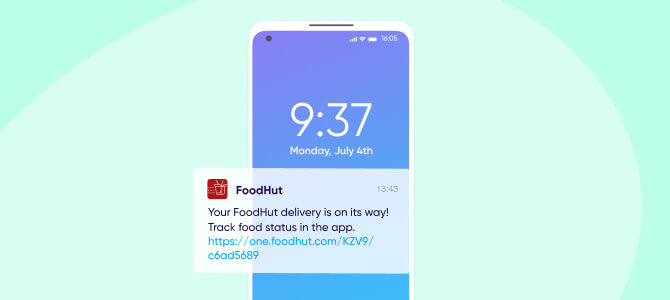How many mobile applications do you have on your phone? 50? 80?
And how many do you actually use?
Studies show that an average person uses nine mobile apps daily and 30 monthly. There are millions of them on the app stores, but few are successful at catching — and holding — our attention.
In fact, users abandon 25% of all apps after only one use. For an app to be successful, it not only needs to meet the user’s needs but also to be engaging, well-designed, and easy to use. And even if you’ve built a solid app, nothing will happen if you don’t market it correctly.
If you want your app to become one of the heavy hitters, you’re going to need a rigorously planned growth strategy. So what exactly is that, and what does it entail?
Glad you asked — read on.
What is app growth?
When we talk about growing your app, it’s about increasing the number of active users in order to boost your revenue.
Getting more downloads is important, obviously, but it’s not the whole story. You also need to engage your existing users so they’ll keep coming back, and find ways to maximize your earning potential.
Studies show that over 90% of mobile apps fail, in that they’re quickly abandoned by users. Of course, in some cases this is because the app just isn’t very good. But many apps struggle due to the absence of a consistent growth strategy.
Here’s what that means and why it’s critical if you want your app to succeed in the long term.
What is an app growth strategy?
Think of your app growth strategy like a marketing plan for your app. It sets out, in detail, all the ways you want to grow your reach, sales, and engagement. You should be clear on what you want to achieve and how you’ll measure success.
A full-funnel growth strategy could include a variety of marketing channels and tactics, such as email marketing, social media, paid advertising, and influencers.
Why do you need an app growth strategy?
It’s tough to get anywhere without a goal. The same goes when you’re trying to grow your mobile app. You must have clarity about where you want to get to, what KPIs you want to hit, and the exact strategies you want to use.
The mobile app market is highly competitive. The Apple App Store has over 1.7 million apps, and the Android store has a whopping 2.7 million apps available. If you want your app to succeed and rise above all your competitors, you need to create and execute a stellar growth strategy.
Now, what’s the difference between a growth strategy and growth hacking?
Growth strategy vs growth hacking
Growth hacking refers to quick marketing wins. It usually involves testing a particular marketing tactic to see if it would work.
A growth strategy is a more sustainable approach that relies on much deeper research and long-term planning. It also factors in all aspects of the business, from design to product development and beyond.
For example, a growth hack can be an email marketing campaign you send for Cyber Monday. A growth marketing strategy, however, would include email marketing as one of the many channels you use to expand your user base.
App growth 101
To illustrate why app growth matters so much, let’s dig into some of the numbers behind the apps. Some of them might surprise you!
What’s the typical growth rate of an app?
The average app has a day 30 retention rate of a mere 3-4%, whereas uninstall rates stand at above 40% within 30 days of install, half of which occur on the first day post install. Clearly, securing engagement and on-going usage is a make or break in this business.
How often do apps get uninstalled?
Uninstall rates are above 40% within 30 days of install, half of which occur on the first day after install. In other words, first impressions are make-or-break in this business.
What percentage of apps are successful?
The grim news is that only 0.5% of apps are successful — in other words, they get enough downloads and active users to be profitable.
Studies show that almost 68% of apps get below 1,000 downloads, nearly 18% get 1,000 or fewer active users, and another 7% close shop because they don’t see enough revenue. That’s brutal.
So how do you make sure your app is successful? Let’s dive into some concrete growth strategies to help you.
App growth in practice: ways to grow your user base
Growing your app is all about growing your user base, and there’s a whole range of strategies and tactics to help you do just that. Which one(s) you choose will depend on your precise goals, your business stage and your budget. Here are some of the top strategies to consider.
1. Use push notifications
First, you need to decide how you’ll communicate with your app users, and push notifications are a great option. They can alert users about new features, remind them to use the app that day, or send a promotion. Experiment with the frequency, timing, and personalization of each push campaign to achieve the best results.
For example, food app ShakeShack used push notifications and in-app messages to release limited-time products. The campaign garnered 55,000 impressions with an astounding 52% click-through rate. As a result, they were able to grow their subscriber base by 184% and boost their retention rates to 52.7%.
2. Set up email marketing campaigns
Next comes email marketing. This channel has one of the highest returns on investment in digital marketing, totaling $36 for every $1 spent, and it’s the primary way people receive information from businesses.
It worked for food app Grubhub, which used a creative email campaign and saw a 100% increase in social media engagement and an 18% boost in brand mentions.
Set up regular email campaigns to communicate with your audience, and automate your email flows to bring back inactive users and re-engage them with your brand.
3. Gather user feedback
Now that you have your two primary forms of communication set up, it’s time to gather feedback from your users.
Your app will only succeed if it meets your users’ needs, so it’s critical to know what those needs are and what features you need to develop or improve to continue to meet them.
Use push notifications and email campaigns to send out regular surveys and offer rewards to make the experience more enjoyable for your customers. You can even create new features based on what your customers tell you.
4. Hire influencers
Another critical ingredient in any growth strategy is social proof. Individuals find user-generated content and recommendations from people they follow on social media much more compelling than branded ad campaigns, and you can use that to your advantage.
Hire influencers on multiple networks like Twitch, YouTube, TikTok, and Instagram, and test out different types of content. Make sure that each influencer’s audience matches your ideal users’ demographics and interests.
Take, for example, Clash. This short-form video app worked with 50 influencers and garnered 250,000 downloads, which pushed it to the #2 spot on the app store in its category.
5. Use gamification
Another great strategy to improve user experience is gamification.
Have you ever seen an onboarding process where you get points for completing certain actions? That’s called gamification and creates an interactive and engaging experience for mobile app users.
Gamification is powerful because it awakens curiosity, fosters competition, and creates a sense of control.
You can implement it by adding points, badges, levels, and leaderboards to your app. Some of the most popular apps with millions of active users use gamification: Duolingo (9.1 million users), Todoist (5 million users), Fitbit (31 million), and Mint (20 million), for example.
6. Make it personal
Personalization is critical when it comes to apps.
A study by PwC shows that customers who feel appreciated are willing to pay 16% more for goods and services, and exhibit increased loyalty. Every user wants to feel special and get content personally tailored to them.
So how do you personalize your user’s app experience?
It’s a good idea to start your onboarding process with a few questions. Then you can tailor the type of content and marketing messages that you display throughout that customer’s journey.
Some apps let their users customize the look and feel of the interface by picking backgrounds, colors, and avatars.
7. Offer subscriptions and paid memberships
Last but not least, you should have various pricing plans available for different types of customers. Some users prefer to have a subscription service they can pay for on a monthly or annual basis.
Apps can also offer paid memberships that unlock special access to content perks or exclusive events. Experiment with different pricing levels and see what brings the most retention.
Create an app growth strategy to scale
An app growth strategy needs to include three key phases to be successful.
1. Onboarding new users: This is where all the top-of-the-funnel campaigns come in. Experiment with different marketing channels to build awareness and acquire new users. Make sure to create a personalized experience for each user so they can move quickly through the onboarding process.
2. Communicating with users: Once you’ve onboarded them, you need to establish communication channels like email marketing, push notifications, text messages, and social media platforms. You should share essential information to bring users back to the app and help them navigate its various features.
3. Delighting existing users: The last part of a solid growth strategy involves retaining existing users. To keep people interested, you can offer things like contests, giveaways, user-generated content campaigns, exclusive content, and rewards or referral programs.
Each of these parts requires a thorough, written-out strategy that includes each channel’s goals, KPIs, tactics, and due dates. And as you grow, continue to analyze your results, A/B test your messaging, experiment with new channels, and gather user feedback.
Now that you understand the importance of a growth strategy — and have picked up some practical tips to get yours off the ground — it’s time to get out there and make your app outshine the competition.
Key takeaways
- The app industry is highly competitive, and most apps don’t make it: you need a solid growth marketing strategy to stand out and succeed.
- A growth strategy differs from growth hacking in that it’s longer-term and provides a wider picture of all the various activities a business should do to grow its app.
- Your app growth strategy can incorporate a number of activities designed to build awareness and engagement. These include communication (push notifications, email), social proof (influencers), and improved user experience (personalization, gamification). Throughout, you should continue to gather and act on customer feedback.
- A successful, scalable app growth strategy has three distinct phases, each with its own detailed plan: onboarding, communication and retention.
FAQs
What exactly is an app growth strategy?
An app growth strategy is a detailed marketing plan that outlines ways to increase your app’s active user base, thereby boosting revenue. It includes various marketing channels and tactics to drive user acquisition and engagement. A good strategy is key to helping your app stand out in a crowded market.
How does a growth strategy differ from growth hacking?
Growth hacking is about quick marketing wins and fast, tactical experimentation, while a growth strategy is a long-term, sustainable approach based on in-depth research and planning. A growth strategy factors in all business aspects, from design to product development.
What are some effective strategies to grow an app’s user base?
Effective strategies include using push notifications, setting up email marketing campaigns, gathering user feedback, employing influencers, using gamification, personalizing the user experience, and introducing subscriptions or paid memberships.
What are the three key phases of an app growth strategy?
The three key phases of an app growth strategy are: onboarding new users through diverse marketing channels, establishing communication with users via channels like email and push notifications, and retaining and delighting existing users with exclusive content, contests, and rewards.
Why should developers focus on user engagement besides just acquiring app downloads?
Studies show that only 3-4% of apps have a retention rate past day 30. So, focusing on user engagement helps ensure users repeatedly return to the app, maximizing long-term revenue potential.










